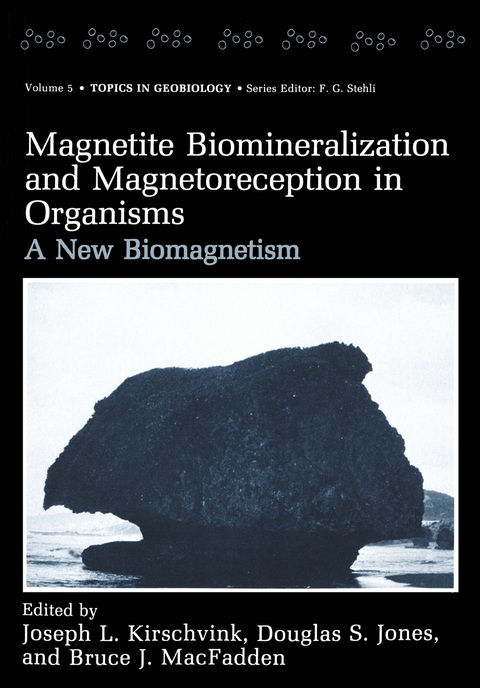
Magnetite Biomineralization and Magnetoreception in Organisms
Springer-Verlag New York Inc.
978-1-4613-7992-8 (ISBN)
I. Introduction and Background.- 1 • Iron Biomineralization: A Geobiological Perspective.- 2 • Ferrimagnetic Properties of Magnetite.- 3 • The Geomagnetic Field: Its Nature, History, and Biological Relevance.- II. Experimental Techniques and Instrumentation.- 4 • An Introduction to the Use of SQUID Magnetometers in Biomagnetism.- 5 • Detection, Extraction, and Characterization of Biogenic Magnetite.- 6 • Studying Mineral Particulates of Biogenic Origin by Transmission Electron Microscopy and Electron Diffraction: Some Guidelines and Suggestions.- 7 • The Cellular Localization of Particulate Iron.- 8 • Large-Volume, Magnetically Shielded Room: A New Design and Material.- III. Magnetoreception: Theoretical Considerations.- 9 • Limits to Induction-Based Magnetoreception.- 10 • Energetics and Sensitivity Considerations of Ferromagnetic Magnetoreceptors.- 11 • Particle-Size Considerations for Magnetite-Based Magnetoreceptors.- 12 • Are Animal Maps Magnetic?.- IV. Magnetoreception and Magnetic Minerals in Living Organisms.- 13 • Mössbauer Spectroscopy of Iron Biomineralization Products in Magnetotactic Bacteria.- 14 • Magnetotactic Microorganisms Found in Muds from Rio de Janeiro: A General View.- 15 • Structure, Morphology, and Crystal Growth of Bacterial Magnetite.- 16 • Biomineralization Processes of the Radula Teeth of Chitons.- 17 • Magnetic Remanence and Response to Magnetic Fields in Crustacea.- 18 • Magnetic Field Sensitivity in Honeybees.- 19 • Magnetic Butterflies: A Case Study of the Monarch (Lepidoptera, Danaidae).- 20 • Magnetoreception and Biomineralization of Magnetite: Fish.- 21 • Magnetoreception and Biomineralization of Magnetite in Amphibians and Reptiles.- 22 • Avian Navigation, Geomagnetic Field Sensitivity,and Biogenic Magnetite.- 23 • Magnetic Remanence in Bats.- 24 • Magnetoreception and Biomineralization of Magnetite in Cetaceans.- 25 • Magnetoreception and the Search for Magnetic Material in Rodents.- V. Human Magnetoreception: An Editorial Introduction.- 26 • Magnetoreception by Man and Other Primates.- 27 • Statistical and Methodological Critique of Baker’s Chapter.- 28 • Human Navigation: Attempts to Replicate Baker’s Displacement Experiment.- 29 • Human Homing Orientation: Critique and Alternative Hypotheses.- 30 • Absence of Human Homing Ability as Measured by Displacement Experiments.- 31 • A Study of the Homeward Orientation of Visually Handicapped Humans.- 32 • An Attempt to Replicate the Spinning Chair Experiment.- 33 • A Cautionary Note on Magnetoreception in Dowsers.- 34 • Human Navigation: A Summary of American Data and Interpretation.- VI. Biogenic Magnetite in the Fossil Record.- 35 • A Search for Bacterial Magnetite in the Sediments of Eel Marsh, Woods Hole, Massachusetts.- 36 • Possible Biogenic Magnetite Fossils from the Late Miocene Potamida Clays of Crete.
| Reihe/Serie | Topics in Geobiology ; 5 |
|---|---|
| Zusatzinfo | 704 p. |
| Verlagsort | New York, NY |
| Sprache | englisch |
| Maße | 170 x 244 mm |
| Themenwelt | Sachbuch/Ratgeber ► Natur / Technik ► Garten |
| Naturwissenschaften ► Biologie ► Evolution | |
| ISBN-10 | 1-4613-7992-X / 146137992X |
| ISBN-13 | 978-1-4613-7992-8 / 9781461379928 |
| Zustand | Neuware |
| Haben Sie eine Frage zum Produkt? |
aus dem Bereich


